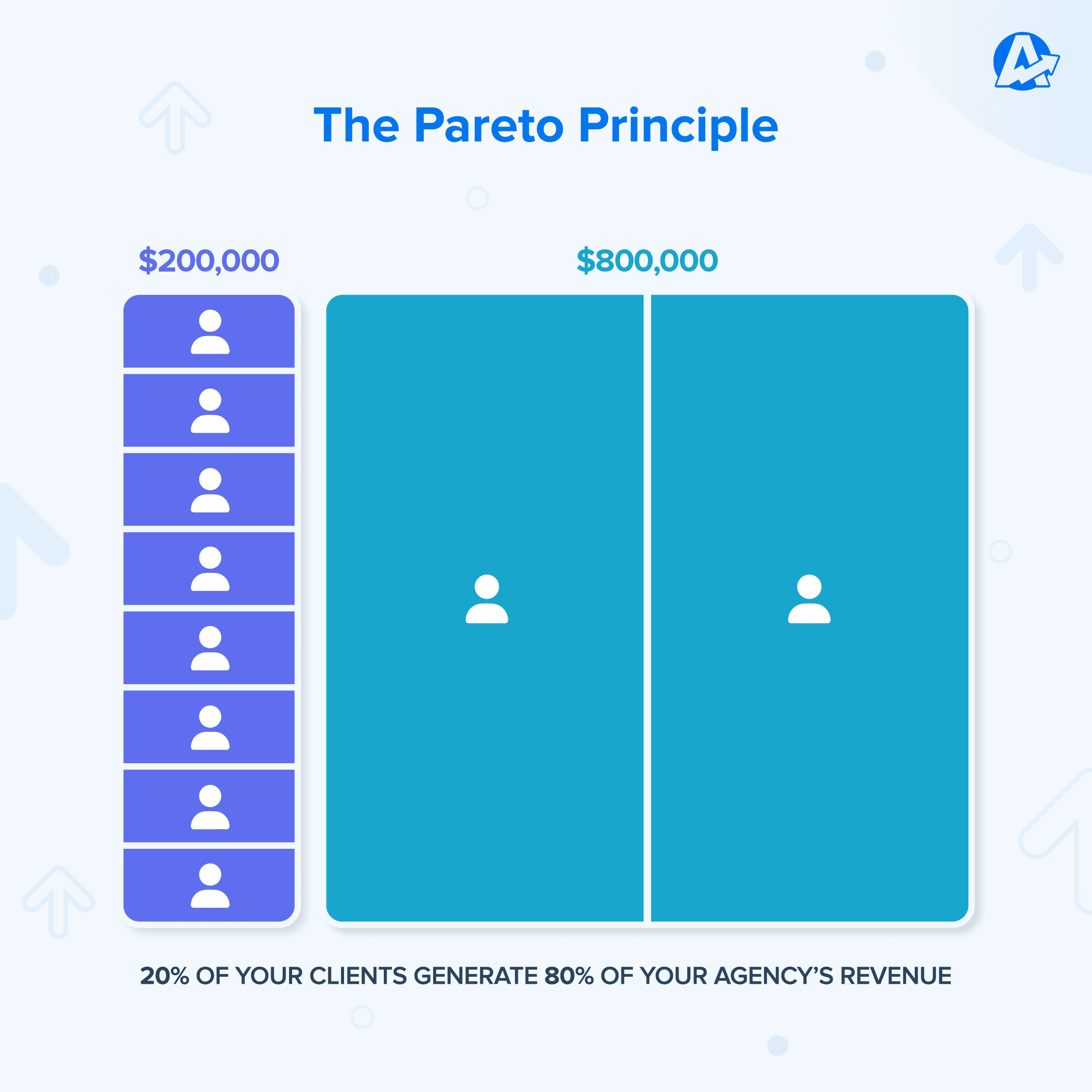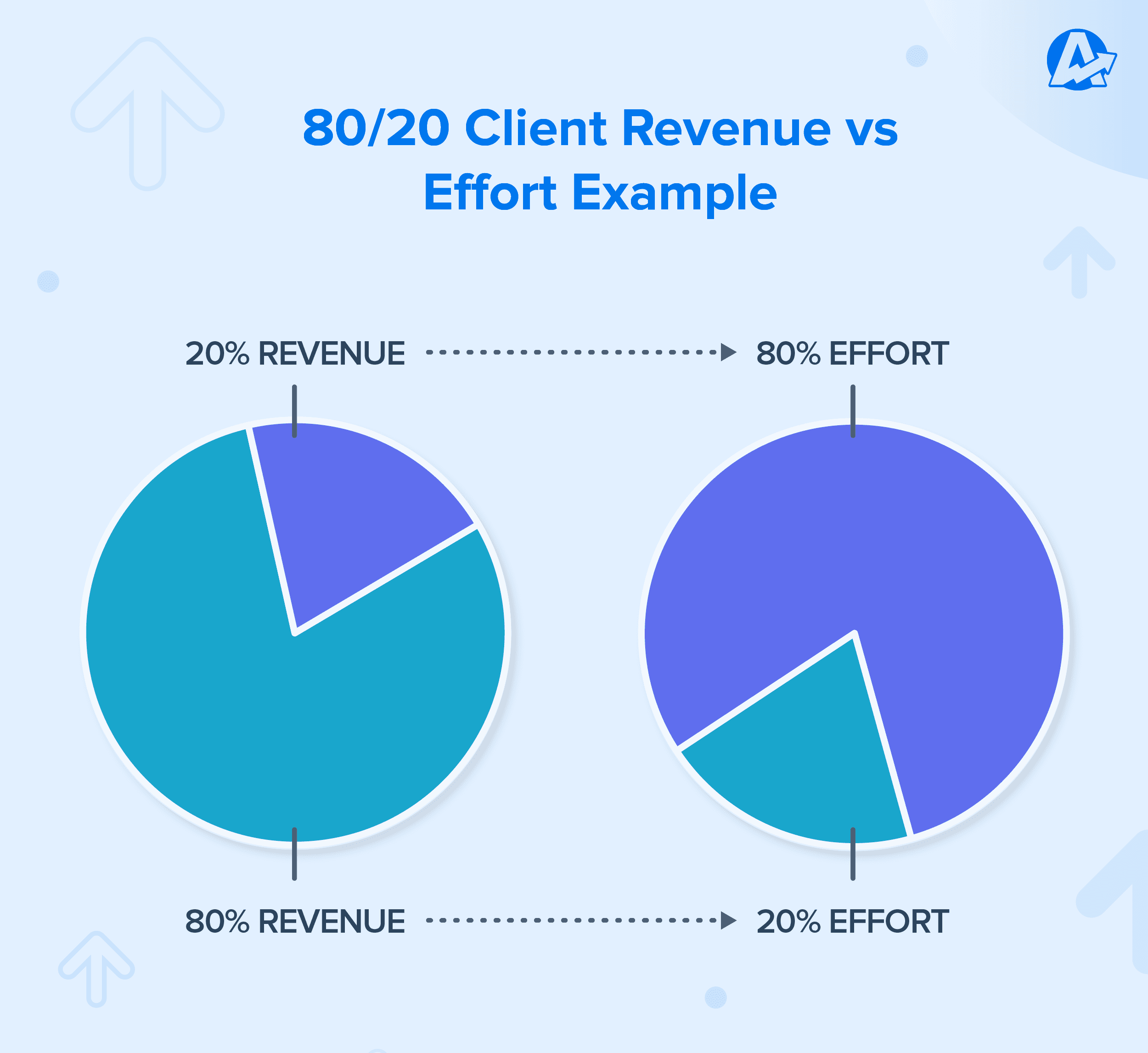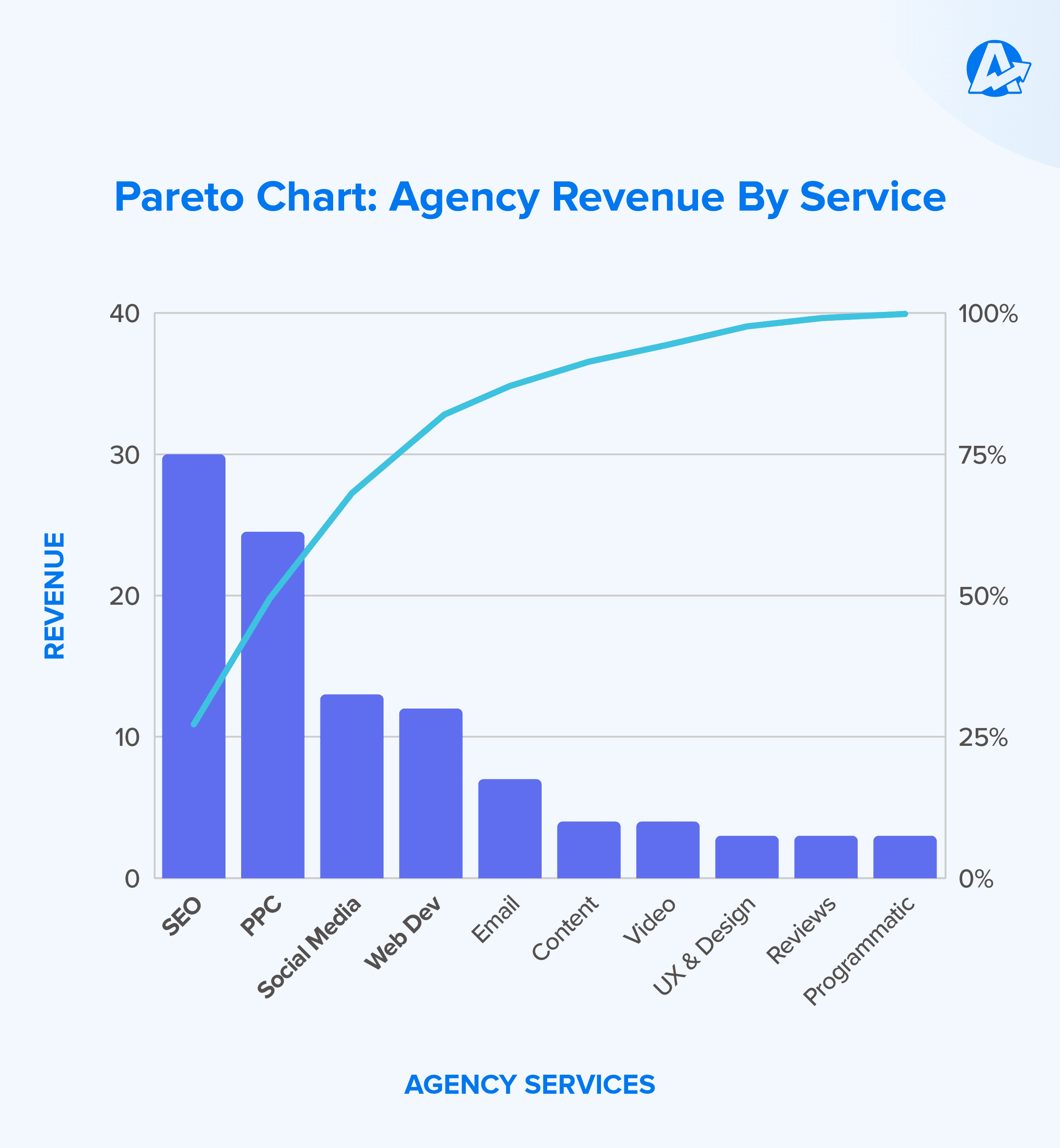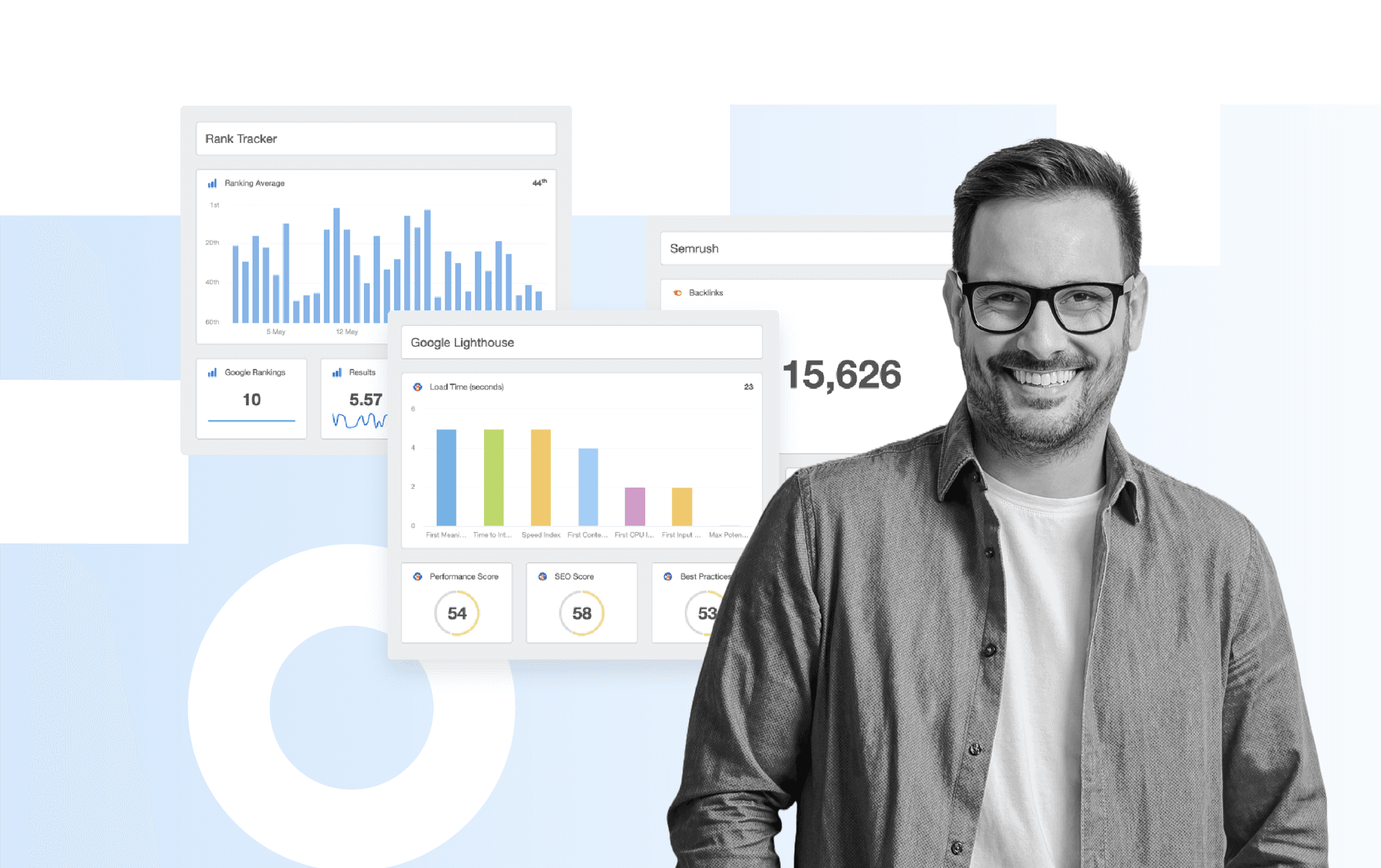Table of Contents
Table of Contents
- What Is the 80/20 Rule–and How Does It Apply To Marketing Agencies?
- How Does the 80-20 Rule Work?
- Quality Control: How Do You Measure It?
- How Does Understanding the 80/20 Rule Benefit Agencies and Their Clients?
- Implementing the 80/20 Rule in Your Agency
- Incorporating the 80/20 Rule in Your Agency Culture
- Balancing the 80/20 Rule Against Innovation
- Summary
7,000+ agencies have ditched manual reports. You can too.
Free 14-Day TrialQUICK SUMMARY:
The 80/20 rule, also known as the Pareto Principle, reveals that in marketing, 80% of a company's revenue often comes from just 20% of its customers. Originating from Vilfredo Pareto's 19th-century observation of wealth distribution, the Pareto Principle helps guide agencies toward maximum efficiency by focusing on high-value customer segments and marketing channels. Discover strategies to apply the 80/20 rule in marketing for enhanced agency productivity and success.
As a marketing agency owner, you know that time is not a luxury you can afford to waste. Your success hinges on the efficacy of your team, and every moment spent on low-value tasks step further from your agency’s goals. That's why the Pareto Principle, also known as the 80/20 rule, is not just a good idea; it's a necessity.
“We live in a world of constraints. There’s never enough time to do everything we’d like to do,” says agency owner Jens Rhoades of Floodlight SEO. “So we must make choices. If we choose the meaningful tasks that actually improve outcomes, then at least will have more to show for our efforts.”
By honing in on the inputs or efforts that generate the most significant results, you can work smarter and not harder, maximizing your agency's potential for success.
In this article, we'll explore how applying the 80/20 Pareto Principle to your agency’s workflows can unlock increased efficiency, better resource allocation, and a renewed focus on high-value tasks and clients.
So let's dive in and see how your teams can be productive–not just busy–with the 80/20 rule.
What Is the 80/20 Rule–and How Does It Apply To Marketing Agencies?
It all started in late 19th century Italy. Italian economist and sociologist Vilfredo Pareto, first observed the principle that later came to be known as the Pareto Principle. He noticed that 80% of the land in Italy was owned by just 20% of the population, while the remaining 80% owned only 20% of the land. Hence Pareto's Principle is most commonly referred to as the 80/20 rule.
Pareto's observation led him to study the distribution of wealth in other countries and industries, and he found similar patterns. In marketing, 80% of a company's revenue may come from just 20% of its customers, or 80% of the traffic to a website may come from just 20% of the marketing channels.
By identifying these high-value customers or marketing channels, agencies can focus their efforts and resources on the most profitable areas, ultimately leading to higher ROI and greater success.
Focusing on high value tasks is incredibly important. Like a gas, menial tasks expand to fill the container they’re in. So if you give them your entire day, week, or career, don’t be surprised if you’ve been exceedingly busy and accomplished nothing.
Jens Rhoades, Owner at Floodlight SEO
When it comes to marketing agencies, the Pareto Principle states that you should prioritize and optimize efforts to achieve greater efficiency and effectiveness in your campaigns and focus on your most productive tasks first.
Let’s look at two common use cases for digital marketing agencies.
Use Case #1: Analyzing Your Top-performing Content
Check which marketing campaigns, content types, or social media platforms produce the highest engagement rates or conversion rates. Optimize your marketing strategies based on those top-performing posts.
Use Case #2: Auditing Your Agency’s Internal Processes
You can also apply the Pareto Principle to identify both the team members and the team activity that drives most of the agency’s success, revenue, or productivity. Identifying these key players and highlighting their strengths helps an agency prioritize tasks and optimize its resources and allocate tasks effectively.
The rule should be applied at the individual team member levels, encouraging them to focus on the 20% of tasks that will generate 80% of their impact.
How Does the 80-20 Rule Work?
The 80/20 principle (aka the Pareto Principle) states that roughly 80% of the effects come from 20% of the causes. In other words, a smaller effort can result in a greater output.
For example, in marketing, it could be that:
20% of a client’s marketing channels generate 80% of the traffic
20% of content generates 80% of the engagement
20% of the team does 80% of the work
20% of the tasks drive 80% of the billable hours
20% of your clients generate 80% of the revenue or profits

It is important to note that the ratio of 80/20 is not set in stone and can vary depending on the situation. It could be 90/10, 70/30, or even 99/1 in some cases. The key is to recognize that a smaller portion of inputs or efforts often leads to a larger portion of results or outputs.
Besides, 80% of revenues from 20% of clients may not be ideal for mitigating agency revenue. If you feel like your agency is putting all its eggs in one basket, you may want to break up a bit to prevent client concentration and increase profitability.
Quality Control: How Do You Measure It?
There are various tools and techniques to measure the Pareto Principle to do quality control of your agency's activities and resolve multiple problems in business management by placing high priority tasks first. Aside from tracking your agency’s utilization rate, CLV, or OKRs vs. KPIs, one of the most common tools is data analysis software.
Method #1: Using Data Analysis Software to Track Productivity
When it comes to analyzing client campaign performance, one of the most commonly used gauges is the data from the marketing platform. But to see the bigger picture, it’s important to have a holistic view of which channel is driving what revenue and costing how much for the Pareto analysis to work.
For example, a client’s Google Ads campaign may be the primary driver of client leads and revenues. But your agency is also responsible for SEO, TikTok, Instagram, Facebook, and more. And because those channels are less mature, they are taking much more time and effort.

Take AgencyAnalytics’ reporting software, for instance. It integrates with 80+ marketing channels, including Google Ads, Facebook Ads, and Amazon Ads, to easily glean insights from the data, prioritize solutions, and stay focused.

Pull your client's real-time metrics into stunning live dashboards and reports and impress your clients with powerful data insights. Start your free 14-day trial now!
Method #2: Using a Pareto Chart to Measure Productivity
The other way to measure the 80/20 rule is by using a Pareto chart: a graphical representation of the Pareto principle.
A Pareto chart typically displays a bar graph that shows the frequency or proportion of various inputs or efforts, sorted in descending order of importance. The chart also includes a line graph that shows the cumulative percentage of total outputs.
For example, you can quickly identify the priority services offered by your agency:

Or measuring how much time your agency spends on everyday tasks:

With a clear view of where your agency spends its time and resources, you identify the activities that are eating into your billable hours–like manual client reporting. It’ll also help you uncover resources that are being under-utilized, preventing you from scaling the agency, like prospecting and sales initiatives.
How Does Understanding the 80/20 Rule Benefit Agencies and Their Clients?
The 80/20 rule applies to various scenarios in an agency, including:
Making strategic business decisions for your agency
Identifying the top 20% of clients, tasks, team members, or processes that produce 80% of your revenue
Analyzing and optimizing your agency’s workload to improve your business management and prioritize solutions
Focusing on your strengths and delegating or eliminating tasks that don’t align with your profitability
Optimizing your content marketing by letting your most productive tasks lead the way to life and time management
Improving your social media reach by focusing your strategy on high-priority tasks and best-performing post types
Setting an action plan and measuring success for client campaigns
Understanding and applying the 80/20 rule benefits data-driven agencies in many ways. Here are some specific examples:
1. Increased Efficiency
By focusing on your top-performing inputs or efforts, you optimize your ops and are more efficient with your teams’ resources, which helps everyone stay focused by focusing on work tasks in manageable segments, and even has mental health benefits!
Being busy is easy and ultimately meaningless. Being effective is what our clients are paying us for.
Jens Rhoades, Owner at Floodlight SEO
Real-world Example: Streamlining Your Content Team
Let’s say your marketing agency has a team of 10 content creators responsible for producing blog posts, social media content, and email newsletters for clients. After analyzing the performance of their content over the past six months, you discover that 20% of your content creators are responsible for generating 80% of the engagement and traffic to your clients' websites.
Now that you’ve done that simple calculation, what do you do next? The answer may seem obvious, but that’s not always the case. There are three options you might consider.
Option #1: Identify the key skills and strategies used by the top-performing content creators and share these insights with the rest of the team. Using the 80/20 rule as a platform for team development is an excellent strategy to implement within the organization.
Option #2: Reallocate resources to give time back to the most impactful content creators. If your best writers are also creating SEO reports or SEO proposals, assign that to someone else to free up more of their time so they can focus on content development. The rest of the team can pick up the slack with the less creative aspects of the role.
Option #3: Identify the underperforming team members and develop a performance improvement plan. If that doesn’t work, it may be time to replace them with someone who can match the capabilities of your top performer.
You have to have those hard conversations as a team that are like, “Well, who’s not an A or B player?’ Because we need to trim the headcount–because it doesn’t serve anybody if the ship sinks.
Trevor Shirk, CEO & Founder of Terrayn Dispensary Marketing
The goal is to ensure that your agency focuses on high-quality content that generates the most significant results for clients. Your agency margins will thank you.
2. Better Allocation of Resources
Focus the team inputs or efforts on those that generate the most significant results. This way, you avoid wasting time, money, or other resources on low-value tasks or clients. Hello, agency profitability!
Real-world Example: Optimizing Your High-value Clients
“90% of your problems come from 10% of your clients,” says Tim Akers, Founder of Akers Digital. And it’s true–sometimes, your most crazy client requests come from a small percentage of clients and cause the majority of issues or consume most of an agency's resources.
There are just some clients who are more labor intensive. We've learned to be careful about spotting those types of clients early on and have modified our contract proposals based on what we've learned from those "high intensity" clients.
Linda Rooney, CEO & Founder at DandeLions Digital
By letting go of these problematic clients, an agency can reallocate its time and resources to focus on high-value clients that generate the most revenue and benefit your agency. Sometimes you just gotta let those toxic clients go (and fire them nicely).
80% of your problems definitely come from 20% of your clients. And if you aren’t careful they’ll fill up 80% of your time. That’s why you have to be diligent and ruthless about setting boundaries. If that doesn’t work, let them go. It’s not a fit. Learn to identify these types of clients so you don’t sell to them in the future.
Jens Rhoades, Owner at Floodlight SEO
3. Stronger Focus on High-value Tasks and Clients
By understanding which tasks or clients generate the most significant impact, businesses can focus their efforts on the areas that matter most. This helps them to prioritize their work and achieve their goals more efficiently.
Real-world Example: Saving Time on Manual Reporting
As an agency owner, you realize that your team manually generating reports takes up a significant amount of their time and is not the most efficient use of your resources.
So you switch to an automated reporting platform that reduces your reporting time by 80% so that your team can focus on higher-value activities such as optimizing campaigns and providing strategic recommendations to clients.
This not only maximizes efficiency but also improves client satisfaction by allowing your agency to dedicate more time and attention to the clients who truly need it.
4. Improved Decision-making
Using the 80/20 rule helps you make more informed decisions to better run your agency’s business and growth strategies. Identifying the most profitable niches, for instance, allows you to decide where to maximize your profits with less effort.
Real-world Example: Selecting a Niche
Let's say your marketing agency specializes in digital advertising in general. By using the 80/20 rule, you analyze your client base and discover that 80% of your revenue comes from clients in the e-commerce industry.
You also notice that you've been getting a lot of referral business from these e-commerce clients, indicating that they are happy with your services and willing to recommend you to others.
Based on this information, you focus your agency's efforts on exclusively serving the e-commerce industry. You develop specialized expertise in the unique challenges and opportunities of e-commerce marketing, and you begin to actively market your agency's services to other e-commerce businesses.
By selecting this niche and focusing your agency's resources on it, you're able to maximize your profits with less effort. You can develop more efficient and effective processes for serving e-commerce clients, and you can build a reputation as the go-to agency for e-commerce marketing.
This, in turn, helps you attract more high-value clients in this niche, creating a virtuous cycle of growth and success for your agency.
We noticed years ago that the vast majority of our clients sales came from search engine optimization. We responded by doubling down and made that the focus of our agency.
Jens Rhoades, Owner at Floodlight SEO
The 80-20 Rule Is Versatile
From choosing a niche for your agency to deciding on your agency pricing to identifying the best strategies to get more referrals, the applications of the 80-20 rule are endless. When you use data to back up your decisions, you can move forward with confidence–and get the rest of your team on board, too.
The next section will explore how to implement it in your day-to-day.
Implementing the 80/20 Rule in Your Agency
Let's take a closer look at how the 80/20 rule benefits marketing agencies in their decision-making processes.
1. Set Clear Goals and Metrics
Before implementing the 80/20 principle, agencies should define clear goals and metrics. This helps them to identify the inputs or efforts that generate the most significant results for your business.
2. Delegate Tasks to Team Members Who Excel in Specific Areas
The 80/20 principle suggests that a small percentage of team members may generate the greatest results. By identifying these top-performing team members, agencies can delegate tasks to them based on their strengths and expertise.
3. Regularly Review and Refine the Implementation Plan
The 80/20 principle is not a one-time fix but an ongoing process. Agencies should regularly review their implementation plan and refine it based on new data or insights.
Agency Tip: Ensure your teams are focusing on high-value tasks. Upsell your existing clients or get more clients to generate the most significant results or outputs.
4. Use Data Analysis Tools
Pareto charts or data analysis software can help agencies identify the efforts that make the biggest difference. These tools help you make data-driven decisions that improve your efficiency and marketing productivity.
Every client is high value, every task is not. Tools that enable differentiation between the value of one task and another, as different in the eyes of the client, are essential.
Daniel Carpenter, Principal at Motive
5. Prioritize High-value Tasks or Clients
Agencies should prioritize high-value tasks or clients and allocate their resources accordingly. It’ll also positively impact your agency structure and eliminate agency productivity killers.
“I think the 80/20 rule can be a great guide-stone for noticing when a team member or client requires too many resources–or when one’s apple cart is overbalanced in a single direction and thus vulnerable to undue influence,” notes Daniel Carpenter, Principal at Motive. However, he encourages away from this kind of thinking if it puts processes above people.
Incorporating the 80/20 Rule in Your Agency Culture
To reinforce the 80/20 rule in your agency culture, it's crucial to provide regular training on how to apply the rule to work, communicate its importance to the team, and set clear goals and metrics to promote accountability.
Empower your team to push back when something doesn't align with the 80/20 framework and celebrate successes when the rule is implemented successfully. Continuous improvement is key, and using data to back decisions ensures the right amount of effort is spent on the right projects.
Remember to prioritize quality over quantity and lead by example as the agency leader to motivate your team to follow suit.
Balancing the 80/20 Rule Against Innovation
One of the drawbacks of the 80/20 rule is that it can create a bit of tunnel vision at an agency and stifle innovation. After all, if Google Ads is generating 80% of the revenue, why invest your agency's time and energy in emerging channels that are not guaranteed to generate a significant contribution to client revenue?
If social media marketing agencies had kept those 80/20 blinders on, nobody would have dug into the potential that TikTok has to offer until their client’s Facebook or Instagram campaigns started to falter.
But there is a way to take a balanced approach to test out new ideas, and that’s by simply slicing out part of that effort pool into a dedicated amount for testing new opportunities.
Rather than running “Madly off in all directions,” as Shakespeare would say, focus on one new idea at a time. Test it, optimize it, and determine if it falls into the 80/20 category for continued expansion.
Whether it ends up being part of your agency’s growth train or gets left at the station, once your team has completed its testing process, you then assign that same bucket of resources to the next great idea.
Again, the 80/20 principle doesn’t mean that you don’t take on new projects or explore new ideas. Moreso, it’s about freeing up some valuable agency time in order to do so.
Summary
"It is so important to focus on high-value tasks and planning with clients," says Linda Rooney, CEO & Founder at DandeLions Digital. "One of the ways we utilize AgencyAnalytics is to compare our month-to-month engagement numbers using the reports we send to clients."
Overall, applying the 80/20 Pareto Principle is essential for achieving long-term success and growth in marketing agencies. By focusing on the high-value tasks or clients that generate the most significant impact, agencies:
Maximize revenue potential
Improve efficiency
Promote a culture of effectiveness
Encourage continuous improvement
It’s time to work smarter, not harder. Apply the Pareto Principle to your client reporting processes and win back billable hours with AgencyAnalytics. Start your free 14-day trial today–no credit card required.


Written by
Melody Sinclair-Brooks brings nearly a decade of experience in marketing in the tech industry. Specializing in B2B messaging for startups and SaaS, she crafts campaigns that cut through the noise, leveraging customer insights and multichannel strategies for tangible growth.
Read more posts by Melody Sinclair-BrooksSee how 7,000+ marketing agencies help clients win
Free 14-day trial. No credit card required.






